Is it possible for a university, steeped in tradition and academic excellence, to have an unofficial mascot that's as unconventional as it is beloved? At Stanford University, the answer is a resounding yes, and it comes in the form of the Stanford Tree, a figure that defies expectations and embodies the university's unique spirit.
Stanford, nestled in the heart of Palo Alto, California, is renowned for its groundbreaking research, innovative spirit, and commitment to fostering a diverse and inclusive community. While the university boasts a rich history and a vibrant athletic program, it has never officially adopted a traditional mascot. Instead, Stanford's athletic teams compete under the banner of the "Cardinal," a nod to the school's signature crimson hue, not the avian creature of the same name.
But the story of the Stanford Tree is far more intricate than simply a matter of color. The "tree" is the official mascot of the Leland Stanford Junior University Marching Band (LSJUMB), and it's also the unofficial mascot of the entire university. This dual role has allowed the tree to become a beloved and instantly recognizable symbol of Stanford, despite its unorthodox nature. Its origins are deeply intertwined with the history of the campus and the cultural landscape of the surrounding area.
- The Ultimate Jimmy Osmond Guide Uncovering The Legends Life And Career
- Tevin Campbell A Timeless Rb Legend
The tree's origin story is a testament to the dynamic character of Stanford and its relationship with its students. It originated in 1975, amid a complex debate surrounding the institution's official mascot. The university previously used the "Indian" as a mascot, a symbol which, in time, became a source of contention due to growing awareness of racial and cultural sensitivities. The debate about a replacement mascot led to several proposals, and eventually, the "Tree" was chosen. This symbol is based on El Palo Alto, a giant redwood tree in Palo Alto, which is featured in the Stanford seal and athletics logo. The tree represents Stanford's connection to the local environment and its legacy.
The tree is not just a costume. It embodies the spirit of Stanford. Its a symbol of the school's unconventional approach and its commitment to innovation and embracing the unexpected. The tree has a devoted following, frequently making appearances at athletic events, campus gatherings, and various university functions.
Last Sunday, Ruby Coulson '27, was named the 46th Stanford Tree, solidifying the continuity of this unusual role. Coulson marks the first tree to enthusiastically cheer on Stanford as part of the Atlantic Coast Conference (ACC), further solidifying the tree's presence in the world of collegiate sports.
- The Ultimate Guide To Icy Melon Edison Discover Its Secrets
- Whos Angela Lansburys Husband The Answer May Surprise You
| Attribute | Details |
|---|---|
| Name | Ruby Coulson |
| Class Year | 2027 |
| Role | 46th Stanford Tree (Unofficial Mascot) |
| University | Stanford University |
| Notable Achievements | First Tree to cheer in the Atlantic Coast Conference (ACC) |
| Significance | Embodies the spirit of the university; upholds tradition. |
| Reference | Stanford News |
The decision to retire the "Indian" mascot came after a period of debate and activism. In December 1975, the Associated Students of Stanford University (ASSU) voted to not reinstate the previous mascot or replace it with an alternative representation. This event was a turning point. The university's commitment to diversity and inclusivity has always been at the forefront of its values. The creation of a new mascot marked a shift towards a symbol representing the institution's ethos.
The story of the Stanford Tree offers insights into the rich and complicated history of the university and its relationship with its identity. The name "Cardinal" originates from the vivid, rich crimson color. It's a symbol deeply rooted in the universitys traditions, and it distinguishes it from several other schools with similar names. The use of the cardinal color is another reminder of the institution's history and traditions.
The Tree's story is more than just a quirky detail. It demonstrates the adaptability and creative spirit that has defined the university since its inception. It also reflects the values of the university community. It stands as a symbol of the institution's values, history, and its distinctive character. The tree continues to represent the unique nature of the institution and its commitment to embracing the unexpected.
Stanford's history is intertwined with the history of Palo Alto. Trees are an important symbol in Palo Alto and on the Stanford seal. The athletic teams represent the university's traditions. The tree is rooted in the local environment and serves as a tribute to the enduring legacy.
The tree is not just a mascot. The tree's story is a testament to Stanford's history and its connection to its surroundings. It highlights the role the university plays in the Palo Alto community. The tree is a symbol and it is a reminder of the institutions commitment to environmentalism and its unique relationship with the local environment.
The image of the tree on the Stanford seal goes hand-in-hand with the university's dedication to academic rigor. The tree, based on El Palo Alto, the redwood tree, serves as an homage to the past. The university's approach to branding is shown in the choice of colors. Cardinal red and Palo Alto green are the two colors often used. The symbol continues to evoke the institution's tradition and values.
The history of the Stanford Tree shows the way in which the university has adapted over time to deal with cultural changes. The story of the Stanford Tree is a reminder of Stanfords rich history, its commitment to diversity, and its innovative spirit. The legacy of the tree serves as a reminder of the values the university stands for, and also reflects the unique spirit that makes Stanford a remarkable institution.
The universitys athletic teams, including the football team, have played a significant role in promoting the Stanford brand. Pop Warner, the Stanford football coach, was the first to utilize the "Indian" as a symbol for Stanford's athletic teams. Stanford has adopted a strategy of adaptation and change and has become a symbol of a cultural and social awakening.
The origins of the Stanford Tree show the history of the institution from its beginning in 1891. The universitys mascot, the cardinal, dates back to the early days of the institution. Leland Stanford, the founder of the institution, named the school in honor of his son, Leland Stanford Jr. Stanford's identity, with its unique history, is an integral part of the campus culture.
The unique role of the tree exemplifies Stanfords innovative spirit. The mascot embodies the universitys history and culture and is representative of its values. The tree continues to be a symbol of Stanfords commitment to the unconventional and its distinctive spirit.
The story of the Stanford Tree provides a special insight into the culture of the university. The tree is a symbol and is a reminder of Stanford's history. The university's spirit of innovation and its commitment to embracing the unexpected are reflected in the way the tree symbolizes the university's values. The tree has carved out a place in the tradition of the university.
In 1930, the athletic department embraced the "Indian" as its mascot. In 1972, after a petition, the institution decided to cease using the symbol. The tree is a symbol and it is a reminder of the evolution of the university's identity.
The Stanford Tree is more than a quirky symbol. It represents the universitys ability to adapt and innovate. The trees unconventional presence embodies the spirit of Stanford and is a tribute to the university's history and its distinct cultural values.



Detail Author:
- Name : Prof. Alfredo Langworth Sr.
- Username : spencer.mable
- Email : stanford21@gmail.com
- Birthdate : 1982-09-24
- Address : 519 Herbert Creek South Darrell, ID 97522-4930
- Phone : 1-234-429-1216
- Company : Leuschke LLC
- Job : Sailor
- Bio : Ratione molestiae autem blanditiis odit sit illum. Cum dolorem laboriosam doloremque ipsum itaque. Et et eligendi provident libero quo maiores exercitationem.
Socials
twitter:
- url : https://twitter.com/kira_official
- username : kira_official
- bio : Et nemo voluptatem exercitationem est dolorem dicta. Ut rerum alias corrupti quia et. Id nulla sunt assumenda eveniet velit.
- followers : 5553
- following : 1386
linkedin:
- url : https://linkedin.com/in/kira_xx
- username : kira_xx
- bio : Qui omnis est dolores enim voluptates.
- followers : 5541
- following : 116
tiktok:
- url : https://tiktok.com/@hegmannk
- username : hegmannk
- bio : Reprehenderit quo inventore vitae numquam quae vel. Modi corrupti iusto atque.
- followers : 3930
- following : 2503
instagram:
- url : https://instagram.com/kirahegmann
- username : kirahegmann
- bio : Excepturi rem dignissimos asperiores earum doloremque. Impedit enim officia a eius blanditiis qui.
- followers : 5424
- following : 2176
facebook:
- url : https://facebook.com/kira_hegmann
- username : kira_hegmann
- bio : Dolor illo quia ipsam. Ab consequatur voluptatibus veniam ullam.
- followers : 4588
- following : 33